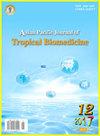Analgesic-like activity of perillyl acetate: In vivo and in silico studies
IF 1.7
4区 医学
Q3 TROPICAL MEDICINE
引用次数: 0
Abstract
Objective: To evaluate the antinociceptive activity of perillyl acetate in mice and in silico simulations. Methods: The vehicle, perillyl acetate (100, 150 and/or 200 mg/ kg, i.p.), diazepam (2 mg/kg, i.p.) or morphine (6 mg/kg, i.p.) was administered to mice, respectively. Rotarod test, acetic acid-induced abdominal writhing, formalin-induced nociception, hot plate test, and tail-flick test were performed. Opioid receptors-involvement in perillyl acetate antinociceptive effect was also investigated. Results: Perillyl acetate did not affect the motor coordination of mice. However, it reduced the number of acetic acid-induced abdominal twitches and licking times in the formalin test. There was an increase of latency time in the tail-flick test of 30 and 60 minutes. Pretreatment with naloxone reversed the antinociceptive effect of perillyl acetate (200 mg/kg). In silico analysis demonstrated that perillyl acetate could bind to μ-opioid receptors. Conclusions: Perillyl acetate has antinociceptive effect at the spinal level in animal nociception models, without affecting the locomotor integrity and possibly through μ-opioid receptors. In silico studies have suggested that perillyl acetate can act as a μ-opioid receptor agonist.乙酸紫苏烯丙基的镇痛活性:体内和计算机研究
目的:评价醋酸紫苏对小鼠的镇痛作用及计算机模拟。方法:分别给小鼠服用载体乙酸紫苏烯丙基酯(100、150和/或200 mg/kg,i.p.)、地西泮(2 mg/kg,i.p..)或吗啡(6 mg/kg,i.i.p。进行了Rotarod试验、醋酸诱导的腹部扭体、福尔马林诱导的伤害感受、热板试验和甩尾试验。阿片受体参与乙酸紫苏的镇痛作用也进行了研究。结果:醋酸紫苏不影响小鼠的运动协调性。然而,在福尔马林试验中,它减少了乙酸引起的腹部抽搐次数和舔舐次数。在30分钟和60分钟的甩尾测试中,潜伏期增加。纳洛酮预处理逆转了醋酸紫苏(200mg/kg)的镇痛作用。计算机分析表明,乙酸紫苏烯丙基酯可以与μ-阿片受体结合。结论:在动物伤害感受模型中,乙酸Perillyl在脊髓水平上具有抗伤害感受作用,不影响运动完整性,可能通过μ-阿片受体。计算机研究表明,乙酸紫苏烯丙基酯可以作为μ-阿片受体激动剂。
本文章由计算机程序翻译,如有差异,请以英文原文为准。
求助全文
约1分钟内获得全文
求助全文
来源期刊

Asian Pacific journal of tropical biomedicine
Biochemistry, Genetics and Molecular Biology-Biochemistry, Genetics and Molecular Biology (miscellaneous)
CiteScore
3.10
自引率
11.80%
发文量
2056
审稿时长
4 weeks
期刊介绍:
The journal will cover technical and clinical studies related to health, ethical and social issues in field of biology, bacteriology, biochemistry, biotechnology, cell biology, environmental biology, microbiology, medical microbiology, pharmacology, physiology, pathology, immunology, virology, toxicology, epidemiology, vaccinology, hematology, histopathology, cytology, genetics and tropical agriculture. Articles with clinical interest and implications will be given preference.
 求助内容:
求助内容: 应助结果提醒方式:
应助结果提醒方式:


